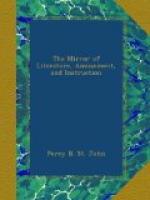Kirton Lindsey. ANNIE R.
* * * * *
LINES ON THE DEATH OF SIR HUMPHRY DAVY, BART.[2]
(For the Mirror.)
Let science weep and droop her head,
Her favourite champion, Davy’s dead!
The brightest star among the bright,
Alas! has ceased to shed its light.
Yet say not darkness reigns alone,
While “Safety Lamps” are burning
on,
And shedding life that never dies.
Around the tomb where Davy lies
J.F.C.
[2] See vol. xiii. MIRROR.
* * * * *
HAMPTON COURT:
BIRTH OF EDWARD THE SIXTH, AND DEATH OF QUEEN JANE SEYMOUR.
(For the Mirror.)
Every hint, every ray of light, which tends, in the most distant manner, to illustrate an obscure passage in the history of our country, cannot we presume, while it affords great pleasure and satisfaction to the student attentively employed in such researches, be deemed either insignificant or uninteresting by the general reader.
The birth of Edward the Sixth must always be regarded as a bright star in the horizon of the Reformation, and one, which tended greatly to blast the prospects of those who were inimical to that glorious change in our religious constitution.
The marriage of Henry the Eighth, with the Lady Jane Seymour,[3] immediately after the death of his former Queen, Anne Boleyn, is so well known as to render it superfluous, if not presuming in us to enlarge upon it in this place: suffice it to say, that the nuptials were celebrated on the day following the execution of Anne, the twentieth of May, 1536, the King “not thinking it fit to mourn long, or much, for one the law had declared criminall."[4] Old Fuller says, “it is currantly traditioned, that at her [Jane’s] first coming to court, Queen Anne Bolen espying a jewell pendant about her neck, snatched thereat, (desirous to see, the other unwilling to show it,) and casually hurt her hand with her own violence; but it grieved her heart more, when she perceived it the King’s picture by himself bestowed upon her, who from this day forward dated her own declining and the other’s ascending in her husband’s affection."[5] About seventeen months after her marriage at the Palace of Hampton Court, Queen Jane gave birth to a son, Edward the Sixth.
The precise period of the birth of this prince has been variously stated by historians. Sir John Hayward,[6] who bestowed considerable labour upon writing his life, places it on the seventeenth of October, 1537; while Sanders,[7] on the other hand, fixes it on the tenth. Herbert, Godwin,[8] and Stow, whom, all[9] his more modern biographers have followed, agree that it happened on the twelfth of the same month, and their testimony is fully corroborated by the following official letter, addressed to Cromwell, Lord Privy Seal, informing him of the birth of a prince:—




